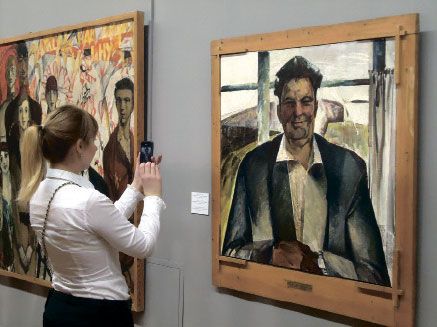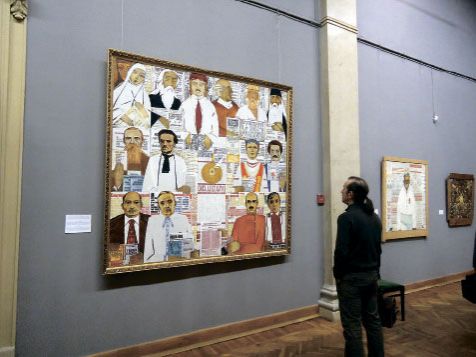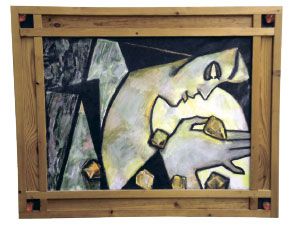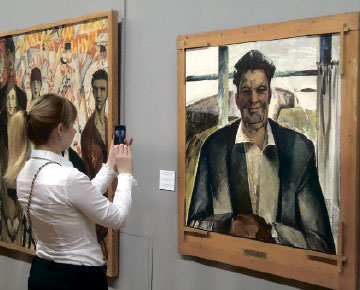Works by Vladimir Stelmashonok aren’t only on show at the museum but inside the stations of Moskovskaya and Ploshchad Pobedy, within the Minsk metro. The graphic artist, painter and set designer, also known for his monumental works, died two years ago; the National Art Museum’s exhibition honours the memory of his diverse creativity. It features canvases from the family collection and from state archives.

Vivid exhibition at National Art Museum reveals multi-faceted talent of People’s Artist of Belarus Vladimir Stelmashonok
His last, symbolic, work was a huge canvas depicting the men of his family; it remained unfinished at his easel. The theme of family life was one he explored tirelessly, repeatedly painting intimate portraits of his parents — well-known doctors, his art critic wife and his children, who followed in his footsteps as artists.
In the 1960s, he gained recognition for his depiction of national heroes (being one of the first to do so). Such were Vladimir’s talents that he even made his frames by hand: in natural materials rather than fine gilding. In this way, they added to each painting, reminding us that heroes are also simple folk, used to working with their hands.
Mr. Stelmashonok was involved greatly in public life, working for some time as a deputy in President Gorbachev’s Supreme Soviet of the Soviet Union; he headed a commission on culture.
His parents were from a humble village, while Vladimir grew up in Minsk, born in 1928. He successfully finished his first year with the Architectural Department of the Minsk State Polytechnic Institute before unexpectedly taking a place at the Vera Mukhina Higher School of Art and Design in Leningrad. He then transferred to the Leningrad Art School’s Theatre and Decorative Art Department.

Much influenced by Vera Mukhina and Kirill Kustodiev, he painted sets for various Leningrad theatres, and attended evening classes at the Academy of Arts. In 1957, he finished his studies at the I. Repin Leningrad Institute for Painting, Sculpture and Architecture. Within the Pictorial Department, under Boris Ioganson, he defended his thesis work, entitled ‘Young Builders of Minsk’. On graduating, he returned to Belarus, where his creative career bloomed.
His enthusiasm was enchanting and he, too, was drawn to those with energy and imagination, who felt the pulse of time. Inspired by those possessing a strong personality, such as academician P. Alsmik, and the People’s Artiste of the USSR G. Shirma, he created his first truly original work: a portrait of People’s Poet of Belarus Yakub Kolas.
Throughout his student years, while the poet was still alive, Vladimir had the chance to sketch the great man, using these drawing to inform his portrait, which he began in 1966. The image of the Pesnyar in the portrait acquires width of generalisation while social motifs are also apparent. The work shows the indissoluble connection of the poet with his native land: Yakub Kolas is depicted in the open air, within a generalised image of his Motherland. A road, both dark and golden, symbolising life’s path, runs across a field, behind the figure, uniting him with his environment.

Vladimir often created simple, unshaded drawings where the figures appear as if cut from the cardboard against the flat surface: his portrait of G. Shirma is one such. Shirma dedicated his to life to collecting precious folk songs, publishing several collections of folk songs, and headed the State Academic Choral Choir of Belarus. The figurative portrait derives from the painter’s comprehension of folk songs. Vladimir went on to paint Shirma, linking his visual image to the melodies he so loved. Set against a background of white embroidered rushniks (a beautiful national ornament of Belarusian folk art) Shirma is an integral element. He appears in an enlightened and lyrical mood, as if immersed in folk music. In this portrait Vladimir Stelmashonok actively uses semantic meaning of the colour. Vladimir’s use of white (characteristic to Belarusian folk art) evokes an atmosphere pure and poetic.
 Mr. Stelmashonok’s talent expressed itself not only through painting but monumental art. The width of creative interests and professional culture enables the painter to work with various materials: glass, mosaic and marble. His classical stained-glass windows, wall paintings and carved plaster sculptures are a sight to behold. One of his stained-glass windows depicts Yanka Kupala: created for the Literary Museum in his honour, sited in Minsk.
Mr. Stelmashonok’s talent expressed itself not only through painting but monumental art. The width of creative interests and professional culture enables the painter to work with various materials: glass, mosaic and marble. His classical stained-glass windows, wall paintings and carved plaster sculptures are a sight to behold. One of his stained-glass windows depicts Yanka Kupala: created for the Literary Museum in his honour, sited in Minsk.
Vladimir’s legacy includes scenography, easel painting, monumental art and graphic works. Generous in nature, benevolent and unselfish, he loved to paint portraits over all else, although watercolour landscapes and drawings prevail among his graphic works. His sharp observations and easy style bring forth images we can believe. His early works were traditional and realistic but, by the 1960s, had become more monumental and decorative, intertwined with white and Belarusian folk ornamentation. Seeking new means of expression, he combined painting with woodcarving, appliqué and collage.
Vladimir Stelmashonok devoted his last 20 years to studying archival materials, creating a series of portraits and compositions on the theme of the historical past of native Belarus.
By Victor Mikhailov











